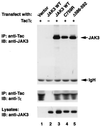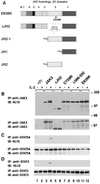Complex effects of naturally occurring mutations in the JAK3 pseudokinase domain: evidence for interactions between the kinase and pseudokinase domains
- PMID: 10629052
- PMCID: PMC85212
- DOI: 10.1128/MCB.20.3.947-956.2000
Complex effects of naturally occurring mutations in the JAK3 pseudokinase domain: evidence for interactions between the kinase and pseudokinase domains
Abstract
The structure of Janus kinases (JAKs) is unique among protein tyrosine kinases in having tandem, nonidentical kinase and pseudokinase domains. Despite its conservation in evolution, however, the function of the pseudokinase domain remains poorly understood. Lack of JAK3 expression results in severe combined immunodeficiency (SCID). In this study, we analyze two SCID patients with mutations in the JAK3 pseudokinase domain, which allows for protein expression but disrupts the regulation of the kinase activity. Specifically, these mutant forms of JAK3 had undetectable kinase activity in vitro but were hyperphosphorylated both in patients' Epstein-Barr virus-transformed B cells and when overexpressed in COS7 cells. Moreover, reconstitution of cells with these mutants demonstrated that, although they were constitutively phosphorylated basally, they were unable to transmit cytokine-dependent signals. Further analysis showed that the isolated catalytic domain of JAK3 was functional whereas either the addition of the pseudokinase domain or its deletion from the full-length molecule reduced catalytic activity. Through coimmunoprecipitation of the isolated pseudokinase domain with the isolated catalytic domain, we provide the first evidence that these two domains interact. Furthermore, whereas the wild-type pseudokinase domain modestly inhibited kinase domain-mediated STAT5 phosphorylation, the patient-derived mutants markedly inhibited this phosphorylation. We thus conclude that the JAK3 pseudokinase domain is essential for JAK3 function by regulating its catalytic activity and autophosphorylation. We propose a model in which this occurs via intramolecular interaction with the kinase domain and that increased inhibition of kinase activity by the pseudokinase domain likely contributes to the disease pathogenesis in these two patients.
Figures









References
-
- Boussiotis V A, Barber D L, Nakarai T, Freeman G J, Gribben J G, Bernstein G M, D'Andrea A D, Ritz J, Nadler L M. Prevention of T cell anergy by signaling through the gamma c chain of the IL-2 receptor. Science. 1994;266:1039–1042. - PubMed
-
- Candotti F, O'Shea J J, Villa A. Severe combined immune deficiencies due to defects of the common gamma chain-JAK3 signaling pathway. Springer Semin Immunopathol. 1998;19:401–415. - PubMed
-
- Candotti F, Oakes S A, Johnston J A, Giliani S, Schumacher R F, Mella P, Fiorini M, Ugazio A G, Badolato R, Notarangelo L D, Bozzi F, Macchi P, Strina D, Vezzoni P, Blaese R M, O'Shea J J, Villa A. Structural and functional basis for JAK3-deficient severe combined immunodeficiency. Blood. 1997;90:3996–4003. - PubMed
-
- Chen M, Cheng A, Chen Y Q, Hymel A, Hanson E P, Kimmel L, Minami Y, Taniguchi T, Changelian P S, O'Shea J J. The amino terminus of JAK3 is necessary and sufficient for binding to the common gamma chain and confers the ability to transmit interleukin 2-mediated signals. Proc Natl Acad Sci USA. 1997;94:6910–6915. - PMC - PubMed
Publication types
MeSH terms
Substances
Grants and funding
LinkOut - more resources
Full Text Sources
Other Literature Sources
Miscellaneous
